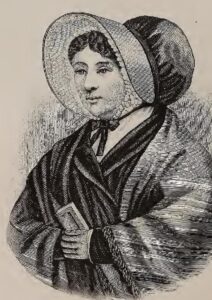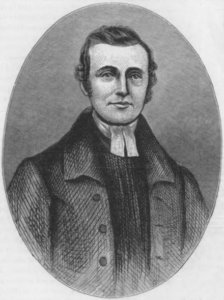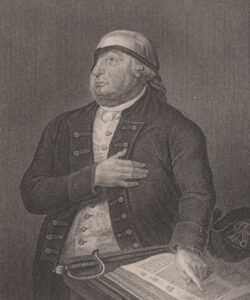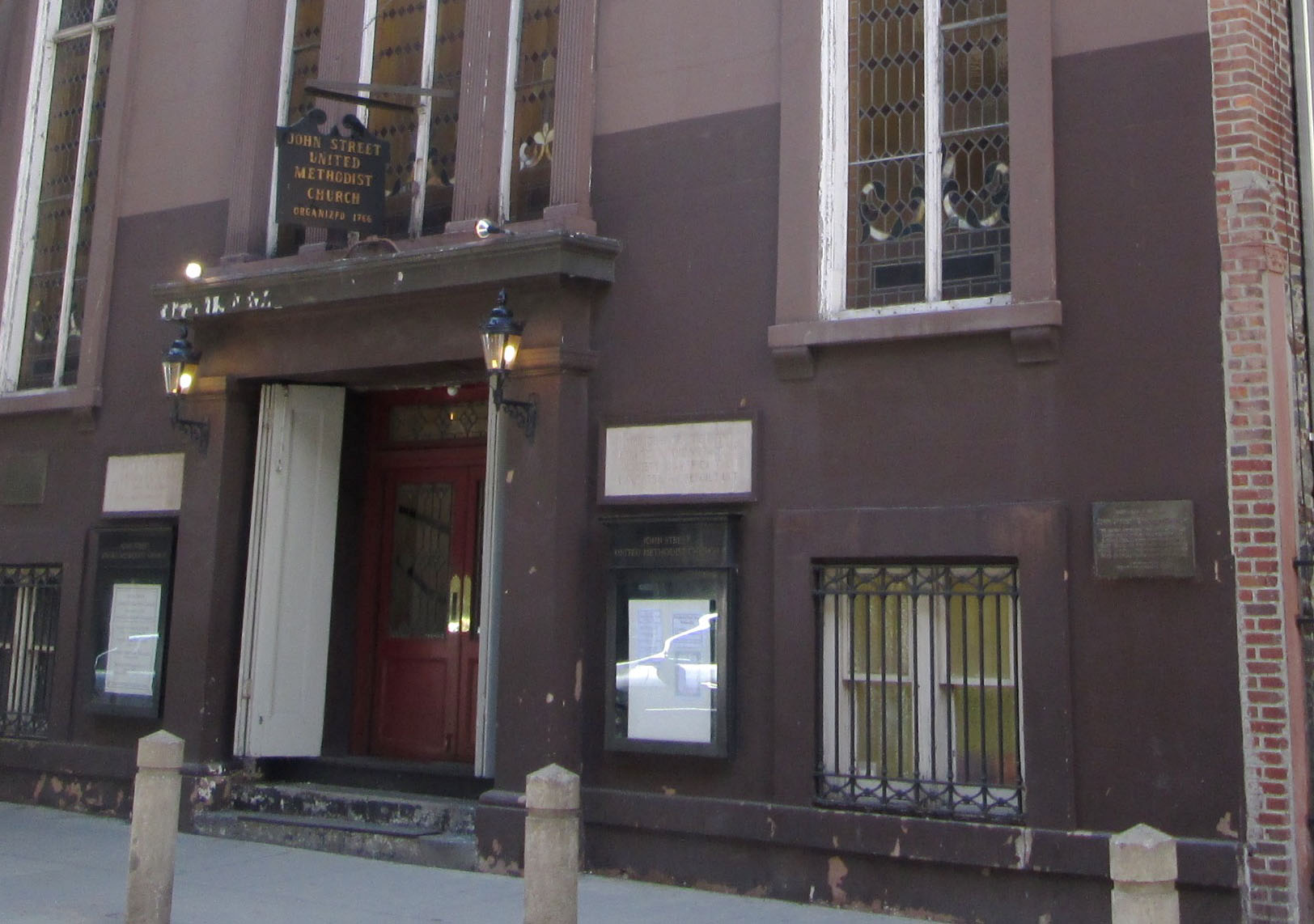Methodist Heritage: New York’s John Street –
By Edmund Robb III –
Good News, January-February 1977 –
What do a one-eyed army captain, an Irish immigrant, and a distraught woman have in common? They were all part of launching Methodism in New York City. Here’s how it all began.
In the early 1760s a group of closely-knit, evangelical Irish emigrated to New York. In a few years, with the social and religious restraints of the old country gone, these new Irish-Americans began slipping away from their warmhearted Christian faith. (These Irish were actually Germans who had been driven out of their Fatherland by the advance of French armies under Louis XIV. These Protestant Germans were never happy in Ireland, so they joined that great migration to the New World.)

Barbara Heck
It took Barbara Heck to wake things up. One night – five years after landing in the city – she discovered her husband, brother, and close friends gambling with cards in her kitchen.
She was outraged! Quickly she swept the playing cards off the table and cast them into the fireplace. Then she firmly rebuked the gamblers. But she knew this wasn’t enough. Something more had to be done!
Still red with anger, Barbara Heck rushed over to her cousin’s house and cried, “Philip, you must preach to us or we shall all go to hell together – and God will require our blood at your hands!”

Philip Embury
But Philip Embury, a 38-year-old carpenter, school teacher, and local Wesleyan preacher, wasn’t so easily convinced. After all, for five years since coming to America he had done nothing to advance Christ’s kingdom.
“Where shall I preach?” he asked timidly. “And how can I preach, for I have neither a house nor a congregation.”
But Barbara Heck was stubborn. “Preach in your own house,” she retorted.
“And who will come to hear me?”
“I will come to hear you,” she insisted.
And she did come – along with four others to Philip Embury’s cottage in September 1766. It was Methodism’s first regular preaching service in America.
Over the winter, the humble Methodist society began growing. Soon Embury’s cottage living room became too crowded and they had to move to new quarters.
After scouting the city they found a rigging loft on Barracks Street. It was an unlikely place for preaching and worship! All around were saloons and military barracks.
But there, on the roughest street in town, these early Methodists set up shop. They built a pulpit, erected benches, and held regular preaching services. On Sunday mornings they gathered at six o’clock to hear Philip Embury preach about Jesus. And they usually met several evenings each week, too. Despite this, these “peculiar” Methodists went regularly to the English Episcopal Church to receive Holy Communion. (Until 1784 Methodists in America were official members of the Anglican Church. John Wesley did allow his local preachers to administer the sacraments of Holy Communion or Baptism. This did not change in England until he died in 1791.)

Captain Thomas Webb
Captain Thomas Webb. One day the Methodists received an unusual boost. A stranger, dressed in the full regalia of an officer in His Majesty’s Army, entered the rigging loft. Tension filled the air. The Methodists’ experience with the British Army had not been good. Had not soldiers tried to break up several societies in England? Perhaps this soldier was about to make trouble here, too. But as soon as the meeting closed, the one-eyed army captain marched to the front and introduced himself as “Captain Thomas Webb, of the king’s service, and also a soldier of the Cross and a spiritual son of John Wesley.”
Captain Webb, as New Yorkers learned to call him, had lost his right eye while commanding troops at the Siege of Quebec in the French-Indian War. As a result he was retired early from active duty and sent home to England to recuperate.
It was during this time that Captain Webb came under the influence of John Wesley’s preaching – and was soundly converted.
Since Captain Webb had been given a preacher’s license by Wesley himself, he was soon invited to begin preaching regularly at the society, alternating with Philip Embury.
Now, many more New Yorkers began attending Wesley’s Chapel. John Wesley must have been right. He said of Webb: “The Captain is all life and fire. Therefore, although he is not deep and regular, many who would not hear a better preacher, flock to hear him. And many are convinced under his preaching.”
The sheer novelty of hearing a well-known army officer preach, “You must repent or be forever damned!” packed people in.
One contemporary wrote, “His figure was portly, his countenance commanding, and he usually wore across his forehead a black ribbon with a blind attached, to cover his wounded eye.”
John Adams, who later became President of the United States, heard Webb preach, and described him as “One of the most eloquent men I ever heard; he reaches the imagination and touches the passions very well, and expresses himself with great propriety.”
Another early writer described the scene this way: “To behold in the pulpit a preacher arrayed in a scarlet coat with splendid facings, having a sword, with the Bible before him, was one of those anomalies which the world, while it ridicules the person, cannot help admiring the boldness of the act.”
Webb declared point-blank to his enthralled listeners that all knowledge and religion were not worth a rush unless their sins were forgiven and they had the witness of God’s Spirit with theirs that they were the children of God.
New Yorkers did admire “the act.” But it was Captain Webb’s warm personality, unusual oratorical abilities, and strong faith which kept them coming back. As a result, within another year, Wesley’s Chapel had to look for larger quarters – again!
John Street. This time the Methodists moved to John Street and built a new chapel. But they had one problem. A law of the colony did not permit dissenters to worship in a church building. So to elude this law, the Methodists built a fireplace in their new chapel, which gave it the official rank of a dwelling.
Methodists have been good fundraisers from the beginning. This first society, for instance, appealed successfully to New Yorkers for financial help. Over 250 responded, from the mayor all the way to a number of slaves.
The new building was opened in October 1768. Philip Embury preached that day from a pulpit he made for the society. He, like Jesus, was a carpenter.
Today, over 200 years later, Philip Embury’s seminal society still stands in the heart of New York City, situated midway between City Hall and Wall Street.
John Street United Methodist Church, as it is now called, is the one church we all own. Because of General Conference action over a century ago, John Street is the only United Methodist Church owned directly by the entire denomination.
As a result, every succeeding General Conference since 1868 has stopped its hectic agenda to receive a formal report from John Street’s trustees, and to elect the local church’s board members for the ensuing quadrennium. (Imagine a General Conference electing your local church’s board members!)
John Street Church continues to minister to people’s needs as it has since 1766. Conditions have changed radically, of course. What was a bustling English port of 18,000 inhabitants, is now the largest city in the United States. Droves of people each day work within walking distance of the church, including employees from international banks, corporate insurance offices, stock and commodity exchanges, and law and government offices.
Each working day many of these people escape from the noisy confusion of the inner city to the sanctuary of John Street United Methodist Church. Here they find solitude and a place to pray.
Captain Thomas Webb is not bellowing vehemently from the pulpit now, but people are still able to respond to the heart-warming Gospel of Jesus Christ, just as they did when Philip Embury and Thomas Webb preached there in 1766!
That’s why John Street is the little church that lasted.
Edmund Robb III was the contributing editor to Good News at the time of this article’s publication. This article appeared in the January-February 1977 issue. Dr. Robb went on to be the founding pastor of The Woodlands United Methodist Church in The Woodlands, Texas. Main photo: Creative Commons.






0 Comments